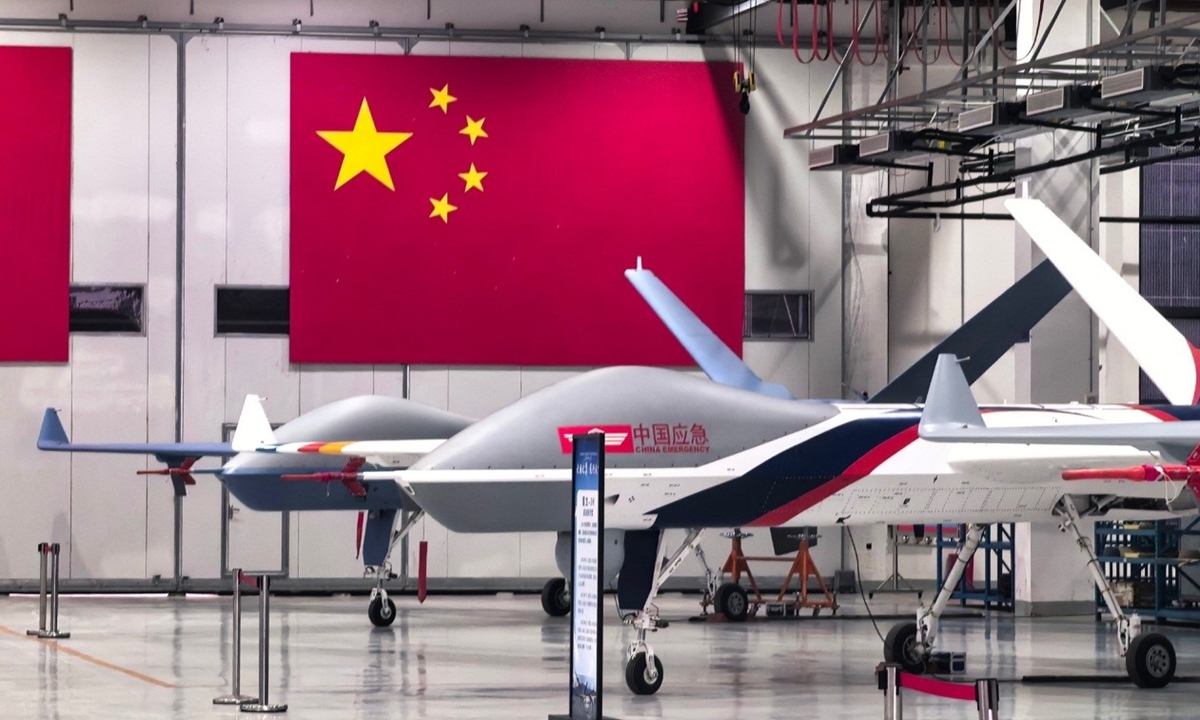
Wing Loong-2H emergency rescue drones wrap up assembly in a production workshop. Photo: Courtesy of Aviation Industry Corporation of China
China's domestically developed Wing Loong unmanned aerial systems (UAS) are expected to expand their applications and become more intelligent, the aircraft's developer recently told the Global Times.
At a time when rapidly developing drones are being underlined by countries around the world, China's Wing Loong series of drones is exploring an innovative development path, as it has performed outstandingly in overseas markets and carried out several major domestic emergency rescue missions.
In a recent media visit to a UAS production and test flight facility under the Aviation Industry Corporation of China (AVIC) in Zigong, Southwest China's Sichuan Province, the Global Times reporter saw medium-to-high altitude, long endurance drones including the Wing Loong-1 and the Wing Loong-2 just wrap up their general assembly, painted with letters "China Emergency" and "China Meteorology." As powerful aerial technology platforms, Wing Loong drones are being used in fields that will safeguard people's lives and property, opening a new path for drones' innovative applications.
The applications of the Wing Loong series drones are still expanding, Li Yidong, chief designer at AVIC UAS, told the Global Times.
In the future, the drones will integrate with new technologies including 5G+, industrial internet, artificial intelligence and big data, and promote more highly efficient applications in more fields together with the whole industrial chain, such as scientific investigation, mapping and logistics, Li said.
Recently, low-cost drones have seen innovative applications and reshaped people's understanding of them. But Li said that these small, inexpensive, easy-to-make drones cannot replace medium and large fixed wing drones.
Li said that there will be technical differentiation, and that different genres of drones will have different applications.
Most of the Wing Loong series of drones are medium altitude, long endurance drones, but taking into consideration factors including market demand and technological development, the Wing Loong series will expand with more members and with more varieties, Li said.
Compared with their foreign counterparts, the Wing Loong drones have obvious technical advantages in terms of long endurance, customization, and support, as they are reliable, have strong environmental adaptability and are expandable, Li said, noting that the Wing Loong drones have won praise from foreign and domestic customers thanks to their performance and cost efficiency.
Drone technologies are expected to see further enhancements in intelligentization, as they will move from remote control and program control to fully autonomous control, Li said.
The intelligentization of future drones will be reflected in target recognition, situational awareness, mission planning and autonomous flight, or even intelligent maintenance, the chief designer said.
New forms of drone industries are also expected, as drones develop toward directions including low cost, high production rate, new energy technologies, near space and super long endurance, Li said.
Another new potential field is single drones being used in multiple missions by carrying different payloads, including for topographic mapping, environment monitoring, technical tests, target indication, damage assessment, early warning, communications, relaying and networking as well as data service, Li said.
Yan Jiazhi, a technology expert at AVIC UAS, told the Global Times that unmanned equipment is expected to be infused with artificial intelligence and assist humans in their missions by sharing their workload, but the decisive factor remains with humans, not machines.
Human intervention is indispensable in missions, particularly when the final decision is to be made, so the scenario in which artificial intelligence makes misjudgments can be avoided, Yan said.
Drones and piloted aircraft usually complement each other, as they have their own advantages in different missions and environments, Yan said, noting that the manned-unmanned integration and hybrid application will play a key role in promoting the development of the aviation industry.




